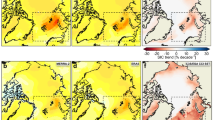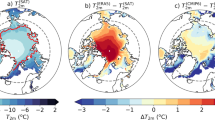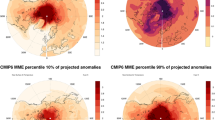Abstract
The existence and magnitude of the recently suggested global warming hiatus, or slowdown, have been strongly debated1,2,3. Although various physical processes4,5,6,7,8 have been examined to elucidate this phenomenon, the accuracy and completeness of observational data that comprise global average surface air temperature (SAT) datasets is a concern9,10. In particular, these datasets lack either complete geographic coverage or in situ observations over the Arctic, owing to the sparse observational network in this area9. As a consequence, the contribution of Arctic warming to global SAT changes may have been underestimated, leading to an uncertainty in the hiatus debate. Here, we constructed a new Arctic SAT dataset using the most recently updated global SATs2 and a drifting buoys based Arctic SAT dataset11 through employing the ‘data interpolating empirical orthogonal functions’ method12. Our estimate of global SAT rate of increase is around 0.112 °C per decade, instead of 0.05 °C per decade from IPCC AR51, for 1998–2012. Analysis of this dataset shows that the amplified Arctic warming over the past decade has significantly contributed to a continual global warming trend, rather than a hiatus or slowdown.
This is a preview of subscription content, access via your institution
Access options
Access Nature and 54 other Nature Portfolio journals
Get Nature+, our best-value online-access subscription
$29.99 / 30 days
cancel any time
Subscribe to this journal
Receive 12 print issues and online access
$209.00 per year
only $17.42 per issue
Buy this article
- Purchase on Springer Link
- Instant access to full article PDF
Prices may be subject to local taxes which are calculated during checkout



Similar content being viewed by others
Change history
22 February 2018
In the version of this Letter originally published, the increments on the y axis of Fig. 3 were incorrectly labelled as ‘0.0; 0.2; 0.2; 0.3’; they should have read ‘0.0; 0.1; 0.2; 0.3’. This has now been corrected in all versions of the Letter.
References
IPCC Climate Change 2013: The Physical Science Basis (eds Stocker, T. F. et al.) (Cambridge Univ. Press, Cambridge, 2013).
Karl, T. R. et al. Possible artifacts of data biases in the recent global surface warming hiatus. Science 348, 1469–1472 (2015).
Fyfe, J. C. et al. Making sense of the early-2000s warming slowdown. Nat. Clim. Change 6, 224–228 (2016).
England, M. H. et al. Recent intensification of wind-driven circulation in the Pacific and the ongoing warming hiatus. Nat. Clim. Change 4, 222–227 (2014).
Chen, X. Y. & Tung, K.-K. Varying planetary heat sink led to global-warming slowdown and acceleration. Science 345, 897–903 (2014).
Solomon, S. et al. The persistently variable “background” stratospheric aerosol layer and global climate change. Science 333, 866–870 (2011).
Santer, B. D. et al. Observed multivariable signals of late 20th and early 21st century volcanic activity. Geophys. Res. Lett. 42, 500–509 (2015).
Meehl, G. A., Hu, A., Arblaster, J., Fasullo, J. & Trenberth, K. Externally forced and internally generated decadal climate variability associated with the interdecadal pacific oscillation. J. Clim. 26, 7298–7310 (2013).
Cowtan, K. & Way, R. G. Coverage bias in the HadCRUT4 temperature series and its impact on recent temperature trends. Q. J. R. Meteorol. Soc. 140, 1935–1944 (2014).
Dodd, E., Merchant, C. J., Rayner, N. A. & Morice, C. P. An investigation into the impact of using various techniques to estimate Arctic surface air temperature anomalies. J. Clim. 28, 1743–1763 (2015).
Rigor, I. G., Colony, R. L. & Martin, S. Variations in surface air temperature observations in the Arctic, 1979–97. J. Clim. 13, 896–914 (2000).
Beckers, J. M. & Rixen, M. EOF calculations and data filling from incomplete oceanographic datasets. J. Atmos. Oceanic Technol. 20, 1839–1856 (2003).
Hansen, J., Ruedy, R., Sato, M. & Lo, K. Global surface temperature change. Rev. Geophys. 48, RG4004 (2010).
Rohde, R., et al. Berkeley Earth temperature averaging process. Geoinfor. Geostat. An Overview https://doi.org/10.4172/2327-4581.1000103 (2013).
Felix, P. & Mauritsen, T. Arctic amplification dominated by temperature feedbacks in contemporary climate models. Nat. Geosci. 7, 181–184 (2014).
Vihma, T. et al. The atmospheric role in the Arctic water cycle: a review on processes, past and future changes, and their impacts. J. Geophys. Res. Biogeosci. 121, 586–620 (2016).
Mears, C. A., Schabel, M. C. & Wentz, F. J. A reanalysis of the MSU channel 2 tropospheric temperature record. J. Clim. 16, 3650–3664 (2003).
Thompson, D. & Wallace, J. M. The Arctic Oscillation signature in the wintertime geopotential height and temperature fields. Geophys. Res. Lett. 25, 1297–1300 (1998).
Inoue, J., Enomoto, T., Miyoshi, T. & Yamane, S. Impact of observations from Arctic drifting buoys on the reanalysis of surface fields. Geophys. Res. Lett. 36, L08501 (2009).
North, G. R., Bell, T. L., Cahalan, R. F. & Moeng, F. J. Sampling errors in the estimation of empirical orthogonal functions. Mon. Weather Rev. 110, 699–706 (1982).
Dee, D. P. et al. The ERA-Interim reanalysis: configuration and performance of the data assimilation system. Q. J. R. Meteorol. Soc. 137, 553–597 (2011).
Zhang, X. et al. Enhanced poleward moisture transport and the amplified northern high-latitude wetting trend. Nat. Clim. Change 3, 47–51 (2013).
Zhang, X., Sorteberg, A., Zhang, J., Gerdes, R. & Comiso, J. C. Recent radical shifts of atmospheric circulations and rapid changes in Arctic climate system. Geophys. Res. Lett. 35, L22701 (2008).
Morice, C. P., Kennedy, J. J., Rayner, N. A. & Jones, P. D. Quantifying uncertainties in global and regional temperature change using an ensemble of observational estimates: the HadCRUT4 data set. J. Geophys. Res. 117, D08101 (2012).
Jung, T. et al. Advancing polar prediction capabilities on daily to seasonal time scales. Bull. Amer. Meteor. Soc. 97, 1631–1647 (2016).
Yamazaki, A., Inoue, J., Dethloff, K., Maturilli, M. & König-Langlo, G. Impact of radiosonde observations on forecasting summertime Arctic cyclone formation. J. Geophys. Res. Atmos. 120, 3249–3273 (2015).
Sato, K. et al. Improved forecasts of winter weather extremes over midlatitudes with extra Arctic observations. J. Geophys. Res. Oceans 122, 775–787 (2017).
Huang, B. Y. et al. Extended reconstructed sea surface temperature version 4 (ERSST.v4). Part I: upgrades and intercomparisons. J. Clim. 28, 911–930 (2015).
Acknowledgements
We thank the National Oceanographic and Atmospheric Administration (NOAA) and the National Centers for Environmental Information (NCEI) for providing the updated global surface air temperature dataset; and the International Arctic Buoy Programme (IABP) and the NASA EOS program Polar Exchange at the Sea Surface (POLES) for making available the Arctic temperature dataset. Special thanks also go to L. Bian and X. Shao for their comments on this research. We also thank the ‘Explorer 100’ cluster system of Tsinghua National Laboratory for Information Science and Technology for computation support. This work was supported by the State Key Development Program for Basic Research of China (grant no. 2013CBA01805), by the National Science Foundation for Young Scientists of China (grant no. 41305054), the Tsinghua University Initiative Scientific Research Program (grant no. 20131089356) and by the China Meteorological Administration Special Public Welfare Research Fund (GYHY201306019) as well as the Tsinghua Global Scholars Fellowship Program. X.Z. was supported by the US NSF (grant numbers ARC-1023592 and ARC-1107509).
Author information
Authors and Affiliations
Contributions
J.H., X.Z. and Y.Luo designed the research and analysed research results. J.H., Q.Z. and M.H. collected data, verified the approach, and conducted computations. J.H. drafted and X.Z. revised the manuscript. Y.Lin also contributed to the revision of the manuscript. All other authors contributed to analysis of research results and improvement of the manuscript.
Corresponding authors
Additional information
Publisher’s note: Springer Nature remains neutral with regard to jurisdictional claims in published maps and institutional affiliations.
A correction to this article is available online at https://doi.org/10.1038/s41558-017-0056-y.
Supplementary information
Supplementary Information
Supplementary Notes 1–6, Supplementary Figures 1–6, and Supplementary Tables 1–3
Rights and permissions
About this article
Cite this article
Huang, J., Zhang, X., Zhang, Q. et al. Recently amplified arctic warming has contributed to a continual global warming trend. Nature Clim Change 7, 875–879 (2017). https://doi.org/10.1038/s41558-017-0009-5
Received:
Accepted:
Published:
Issue Date:
DOI: https://doi.org/10.1038/s41558-017-0009-5
This article is cited by
-
Temperature optima of a natural diatom population increases as global warming proceeds
Nature Climate Change (2024)
-
Warming-induced hydrothermal anomaly over the Earth’s three Poles amplifies concurrent extremes in 2022
npj Climate and Atmospheric Science (2024)
-
Simulation of the Ecosystem Productivity Responses to Aerosol Diffuse Radiation Fertilization Effects over the Pan-Arctic during 2001–19
Advances in Atmospheric Sciences (2024)
-
Another scanning test of trend change in regression coefficients applied to monthly temperature on global land and sea surfaces
Theoretical and Applied Climatology (2024)
-
Newly reconstructed Arctic surface air temperatures for 1979–2021 with deep learning method
Scientific Data (2023)



